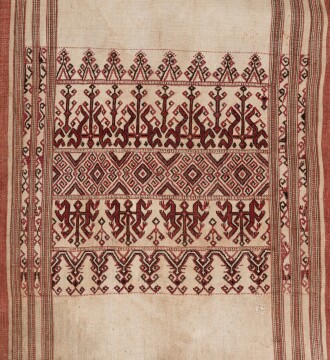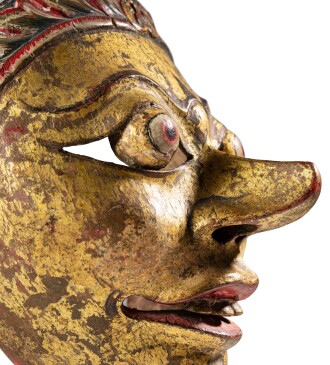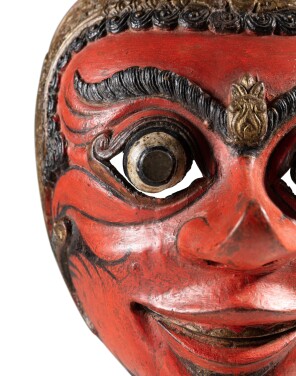T he INDONESIA auction comprises a carefully-curated selection of pieces which together, tell the story of this characterful and nuanced territory situated at the crossroads of Asia and Oceania, at the nexus of trade routes and human migration. Here, we discover the art of Indonesia offers a diversity of influence while never compromising its own originality. In this archipelago, Indian, Chinese and European inspirations combine with local customs and concepts to spectacular effect.
In INDONESIA, statuettes and amulets are presented next to a notable collection of ceremonial textiles, assembled over thirty years by a passionate collector during his many trips to the jungles of Borneo. The works selected for the sale transport us to a world where spirits and ancestors shape the heart of creative imagination and elegance of form and technical virtuosity honour ancient rituals, in objects intended to honour, repel or protect from spirits.
From the Leti Islands to Sulawesi, from the ancestor figures of the Dayak to the famous pua of the Iban, this sale invites us to travel and discover the spirit and beauty of the world's largest archipelago.


Growing up in a musical and artistic family, Amann was first introduced to tribal sculpture in the 1960s by the Expressionist painter Otto Dix, a neighbour of his parents on the Bodensee, who avidly collected African and Oceanic art. This introduction sparked a fascination that along with his professional musical career eventually led Amann to Indonesia and gave great meaning to his life.
‘I only really became aware of Indonesian textiles while travelling there. On my first trip to Bali, in the 1970s, I discovered a small art store … dealers from all over Indonesia stopped by to offer their treasures from Sumatra, Java, Borneo, Sulawesi, Sumba, Flores, Timor, and Lombok and other islands. This is how I discovered that there is probably no other region in the world which has weaving traditions so rich and diverse. Over the following years I visited many of these islands, searching for textiles…’ (Heribert Amann, 2013)
But it was in Borneo that he found his true passion, the textiles of the Iban Dayak. While traveling along the Katibas and Rejang rivers with local guides, Amann describes staying in the longhouses of the Iban people. It was here that he discovered pua kumbu, fabulous warp ikat textiles of complex, compelling patterns. Central to the culture of the Iban Dayak, the pua kumbu, a multicoloured ceremonial cloth, is believed to carry the spirit of the ancestors and to protect the owners. Among the rarest textiles produced by the Iban are the pua sungkit, in which supplementary wefts are wrapped around warp threads to produce the pattern against a red ground. ‘Some designs are inspired by Indian trade cloths,’ says Amann, ‘while others carry abstract illustration of human beings or rows of paired snakes biting into their tail ends.’
While Amann’s pua acquisitions are rightly famous, one of the glories of his collection is the variety of textile typologies, including kain kebat and pilih, and the opportunity provided to compare the work of different regions and tribal groups. Appreciative of the complexities of the ikat weaving process. His own criteria for understanding the quality of the textiles was based on ‘colour, ikat and design’ – the first two being measures of technical aplomb, the last a test of imagination and creativity.
Amann has described his ‘sizable and meaningful collection’ as his ‘joy and inspiration’, while individual pieces are still evocative of particular people and places. ‘When I look at certain textiles, I am back on the moment of our first encounter and remember the people I met. Again, I wonder at the diligence of the woman who prepared the cotton yarn, painstakingly tied up the warp-ikat patterns, managed the dyeing process… I marvel how the women in the past were able to produce the convoluted patterns.’

From the 11th century onwards a new form of performing art developed on the island of Java: mask theater or wayang topeng.
Initially performed by professional dancers for members of the aristocracy in princely courts, such as that of Yogyakarta, the tradition of wayang topeng evolved over time to become a form of popular entertainment. As dancers took to the streets, they began appearing at weddings and other celebrations, but still maintained the strict codification of their art. At first their repertoire was confined to the great Sanskrit epics, but over time it began to expand to includes stories of Javanese folk heroes.
The acting itself, with its slow, hieratic movements and its sumptuous costumes, allowed the dancers to communicate a range of emotions despite the frozen expression on their face. Highlighted by the play of light and shadow that help convey heightened emotions and bring the crux of the action to a climax, these exceptional masks were essential to the performance. Great care was taken in the carving and polychromatic adornment of the topeng masks, truly elevating them as works of art in their own right.
This extraordinary collection of topeng masks offers a remarkable panorama into a theatrical production that is unique to Javanese culture. It is a reflection of traditions and ancestral myths and offers an insight both into the history and the stories shared by an entire culture. Each mask individually depicts a well-known or lesser-known character from Javanese theater such as Hanuman, the monkey-like Hindu god, or Kelana, the ferocious king.
Read Less
































